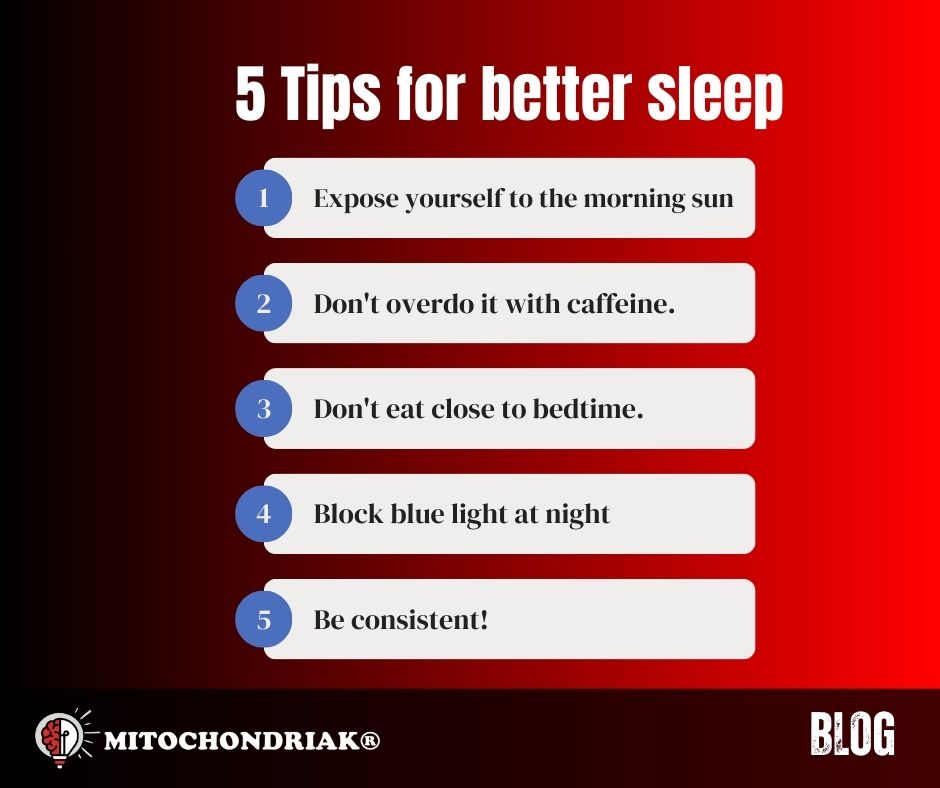5 practical Mitochondriac tips for better sleep
Sleep is an essential part of our daily lives and plays a key role in maintaining our physical and mental well-being. We spend almost a third of our lives sleeping, it is the most important for our health, but at the same time we often neglect it.
In today's article, we will show you 5 simple practical tips on how you can improve your sleep immediately.
How circadian rhythm, blue light, melatonin and sleep are related:
Sleep is regulated by the body's internal clock, known as the circadian rhythm. This complex system relies on various environmental cues, including light, to synchronize our sleep-wake cycles. It's no secret today that blue light, through melanopsin, regulates our circadian rhythm. [R]
While exposure to natural light during the day helps regulate (and reset) our circadian rhythm and promotes wakefulness, darkness and the absence of blue light signal the body to produce melatonin, a hormone that regulates sleep.. [R, R]
This means that plenty of natural sunlight during the day, but also the absence of blue light in the evening, support our circadian rhythm and better sleep.
5 practical tips for better sleep:
Now that we understand the importance of natural light and circadian rhythm, as well as eliminating blue light in the evening, let's take a look at how to improve your sleep with 5 simple tips.:

1. Get some morning sunlight and be active..
Getting enough sunlight during the day can improve your sleep quality at night. Your body and brain respond to the light you are exposed to during the day, and some types of light are better than others when it comes to sleep quality. So always try to get outside, every day, consistently, and get some natural sunlight. Especially in the morning.
You can also include regular exercise and movement, which increase your body temperature and metabolism, which can help you sleep better.

2. Avoid caffeine in the afternoon.
Caffeine can give us a momentary "kick", but as you probably know, our bodies then metabolize it for some time. And although some of us can metabolize caffeine faster, it usually remains in our circulation for several hours.
Therefore, try not to consume any caffeine at least after 12 noon and see for yourself how much your ability to fall asleep and consequently your productivity during the day will improve.

3. Don't eat shortly before bedtime.
Digestion and metabolism are also governed by circadian rhythms. Your organs work hard while you sleep, processing fat and preparing your body for the next day. They work more efficiently when you eat at about the same time each day, helping to create long-term rhythms.
Therefore, try to eat your last meal a few hours before bedtime, for better melatonin secretion.

4. Limit blue light, especially 2 hours before bed and at night.
The blue light emitted by our phones, TVs, and computers brings with it many negatives because it "tricks" our brain and circadian rhythm into thinking it's daytime, which can impair our sleep quality and ability to fall asleep..
Therefore, try to limit blue light, at least in the evening hours. An easy way is to get suitable and proven blue light blocking glasses or even buy suitable indoor lighting that does not contain blue light!
Indoor lightning solutionsBlue light blocking glasses
5. Be consistent.
Consistency applies to everything. It applies to your morning exposure to sunlight, your meals, and even your bedtime at approximately the same time.
Therefore, instead of one "strict" day a week when you will follow everything, try to start gradually. Get up at about the same time, try to have dinner a few hours before bedtime, use ideal lighting without blue light in the evening, move regularly and watch for yourself how your sleep improves.
Bonus tip:
If you want to "kick" your sleep even further, and with it your melatonin and mitochondria, try red and infrared light therapy.
However, if you decide to go to therapy, keep these 2 things in mind::
- Timing and duration:
If you are using the therapy for sleep, aim to use red light therapy in the evening, preferably a few hours before bed. It is best to expose yourself to red light or a combination of RED + NIR for approximately 10 minutes from a distance of 45 to 100 cm.
- Choose the right device:
If you are considering a red and infrared panel, invest in a quality device. We recommend devices where you are sure that they have reduced flicker and will also provide you with optimal wavelengths (around 670 to 850 nm)..
- https://pubmed.ncbi.nlm.nih.gov/23182016/
- https://www.ncbi.nlm.nih.gov/pmc/articles/PMC3499892/
- https://pubmed.ncbi.nlm.nih.gov/17321060/
- https://www.ncbi.nlm.nih.gov/pmc/articles/PMC6725211/
- https://www.ncbi.nlm.nih.gov/pmc/articles/PMC10001099/
- https://pubmed.ncbi.nlm.nih.gov/27276063/
- https://www.melatonin-research.net/index.php/MR/article/view/19/208
- Suofu Y, et al. (2017) Dual role of mitochondria in producing melatonin and driving GPCR signaling to block cytochrome c release. PNAS 114 (38): E7997-E8006.
- He C, Wang J, Zhang Z, Yang M, Li Y, Tian X, Ma T, Tao J, Zhu K, Song Y, Ji P, Liu G (2016). Mitochondria Synthesize Melatonin to Ameliorate Its Function and Improve Mice Oocyte's Quality under in Vitro Conditions. Int. J. Mol. Sci. 17 (6): E939. doi: 10.3390/ijms17060939.
- Wang L, Feng C, Zheng X, Guo Y, Zhou F, Shan D, Liu X, Kong J. (2017) Plant mitochondria synthesize melatonin and enhance the tolerance of plants to drought stress. J. Pineal Res. 63 (3): E12429. doi: 10.1111/jpi.
- Odinokov D, Hamblin MR (2018) Aging of lymphoid organs: Can photobiomodulation reverse age-associated thymic involution via stimulation of extrapineal melatonin synthesis and bone marrow stem cells? J. Biophot. 11 (8): e201700282.
- https://www.ncbi.nlm.nih.gov/pmc/articles/PMC2796659/
- https://pubmed.ncbi.nlm.nih.gov/18081143/
- Konturek PC, Brzozowski T, Konturek SJ. Gut clock: implication of circadian rhythms in the gastrointestinal tract. J Physiol Pharmacol. 2011 Apr.
- St-Onge AP, Mikic A, and Pietrolungo C. Effects of Diet on Sleep Quality. Advances in Nutrition. 2016 Sept.
.png)
.jpg)

.jpg)
.jpg)